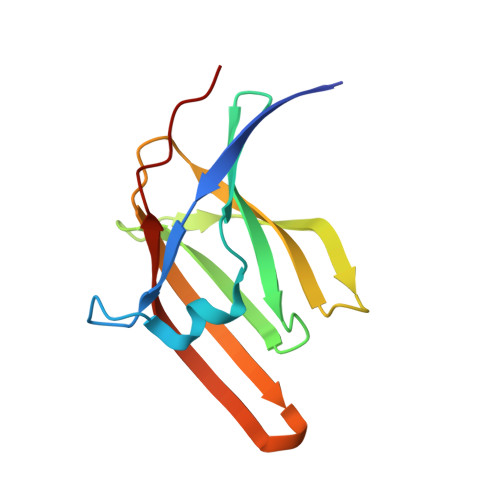Iron-Coordinating Tyrosine Is a Key Determinant of NEAT Domain Heme Transfer.
Grigg, J.C., Mao, C.X., Murphy, M.E.(2011) J Mol Biol 413: 684-698
- PubMed: 21893067
- DOI: https://doi.org/10.1016/j.jmb.2011.08.047
- Primary Citation of Related Structures:
3QZL, 3QZM, 3QZN, 3QZO, 3QZP - PubMed Abstract:
In humans, heme iron is the most abundant iron source, and bacterial pathogens such as Staphylococcus aureus acquire it for growth. IsdB of S. aureus acquires Fe(III)-protoporphyrin IX (heme) from hemoglobin for transfer to IsdC via IsdA. These three cell-wall-anchored Isd (iron-regulated surface determinant) proteins contain conserved NEAT (near iron transport) domains. The purpose of this work was to delineate the mechanism of heme binding and transfer between the NEAT domains of IsdA, IsdB, and IsdC using a combination of structural and spectroscopic studies. X-ray crystal structures of IsdA NEAT domain (IsdA-N1) variants reveal that removing the native heme-iron ligand Tyr166 is compensated for by iron coordination by His83 on the distal side and that no single mutation of distal loop residues is sufficient to perturb the IsdA-heme complex. Also, alternate heme-iron coordination was observed in structures of IsdA-N1 bound to reduced Fe(II)-protoporphyrin IX and Co(III)-protoporphyrin IX. The IsdA-N1 structural data were correlated with heme transfer kinetics from the NEAT domains of IsdB and IsdC. We demonstrated that the NEAT domains transfer heme at rates comparable to full-length proteins. The second-order rate constant for heme transfer from IsdA-N1 was modestly affected (<2-fold) by the IsdA variants, excluding those at Tyr166. Substituting Tyr166 with Ala or Phe changed the reaction mechanism to one with two observable steps and decreased observed rates >15-fold (to 100-fold excess IsdC). We propose a heme transfer model wherein NEAT domain complexes pass heme iron directly from an iron-coordinating Tyr of the donor protein to the homologous Tyr residues of the acceptor protein.
Organizational Affiliation:
Department of Microbiology and Immunology, Life Sciences Institute, The University of British Columbia, Vancouver, BC, Canada V6T 1Z3.

















